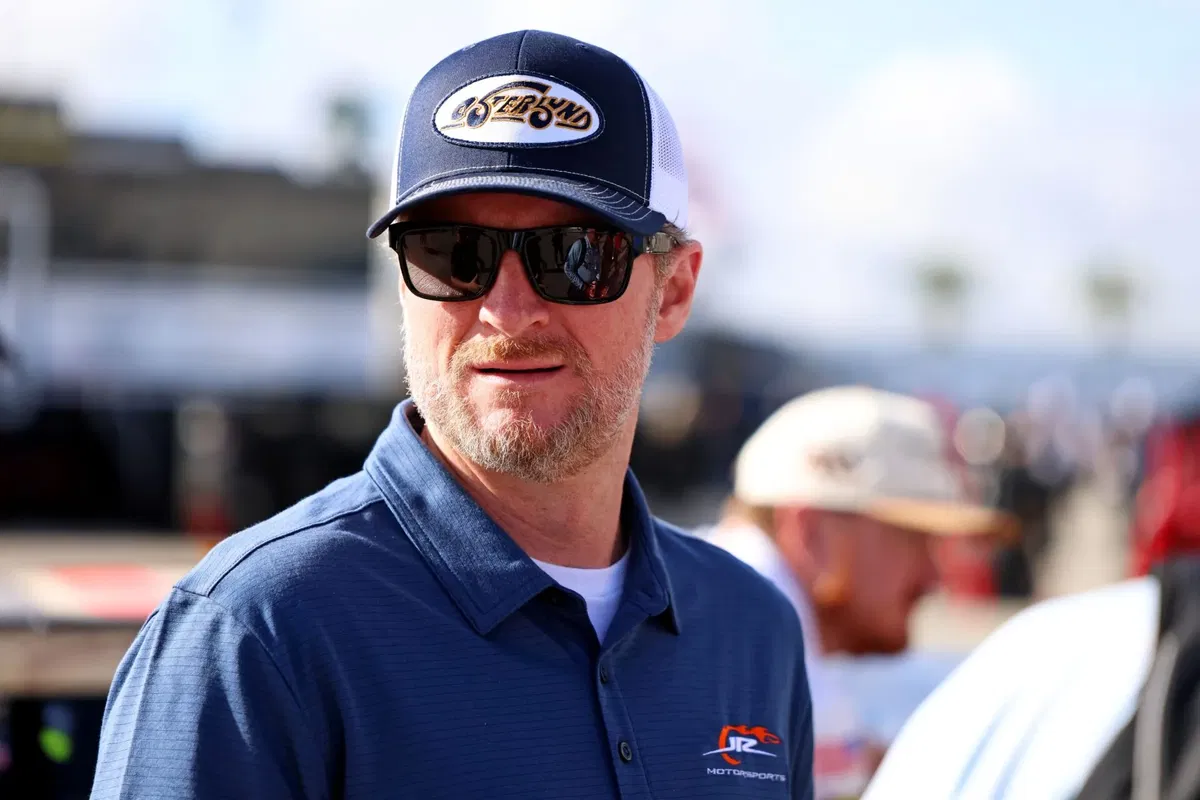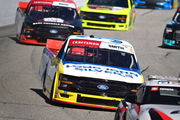
Imago
Credit: Peter Casey-Imagn Images

Imago
Credit: Peter Casey-Imagn Images
In spring 2024, NASCAR drivers were caught off guard. As soon as the Food City 500 race was flagged off, Cup drivers found their tires wearing off in less than 50 laps. The scrambling strategy and thrilling lead changes (54) that followed excited fans to the core. And Goodyear embarked on an experiment that went on for over two years. After two failed attempts at the same track, it finally struck gold in last Saturday’s Night Race.
Watch What’s Trending Now!
The Bass Pro Shops Night Race featured 36 lead changes, the third-most in Bristol’s history. Christopher Bell navigated the flutter of challenges to prevail in the end, with his rivals racking their brains over the entire 500-lap event. Despite the thrill, Dale Jr. pointed out a few changes from when he raced.
ADVERTISEMENT
Dale Jr. traces a gloomy trajectory
Goodyear introduced a new right-side tire designed to wear in 100 laps. But the tires did not peel off during Friday’s practice session, as teams were able to run well over 50 laps without much wear. The temperature was 83 degrees ambient and 100 degrees on the surface. Therefore, everybody expected another snoozefest just like the previous two races. On Saturday night, the green flag waved with an ambient temperature of 71 degrees and a track temperature of 89 degrees. And around lap 25, No. 22 Ford spotter Coleman Pressley told Joey Logano, ‘It’s happening.’ And just like that, a reiteration of the 2024 spring event was underway. But what concerned Dale Jr. was the massive disparity with the older Bristol races. “The direction that Goodyear’s going, maybe it’s a bit extreme,” he said.
Dale Earnhardt Jr. won a Cup race and an Xfinity race in Bristol, both in 2004. Firstly, he pointed out the difference in the temperature factor between his time and the present day. Dale Jr. said, “For all of my life, I always associated tire wear with heat… and if you would have a cool temperature, you would have less falloff, less wear. Cool temperatures weren’t conducive to good racing or wear. But now, it’s the opposite…It’s my opinion that the way they make the tire – the chemicals or the lack of chemicals…part of the process and infused into the rubber, had changed the tire and how the tire reacts to different surfaces and temperatures. So we’re starting to see this across the board in short-track racing as well.”

Imago
NASCAR, Motorsport, USA Bass Pro Shops Night Race Sep 13, 2025 Bristol, Tennessee, USA NASCAR Cup Series driver Austin Cindric’s 2 catches on fire during a pit stop at Bristol Motor Speedway.
Another factor that concerned Dale Jr. was the fabric of the tires. The veteran said that the rubber debris that NASCAR had to sweep out during a Stage 1 caution also differed from his times. He said, “Whether it was the Hoosier tires…or Goodyear’s radials, they used to have oils and chemicals and stuff, when it would wear, the balls of the entire debris would go off the racetrack…you could smear it in your hand. Now, when the tire does wear, it’s a fine powder. It is completely foreign to what we’ve known for years.” He continued, “So now we’re kind of relearning what instigates the tire to wear and what conditions we need.”
ADVERTISEMENT
What is more, Dale Earnhardt Jr. is hardly alone in expressing concerns. The Goodyear tire conversation threw a pall of speculation over the Cup Series garage.
ADVERTISEMENT
Top Stories
Greg Biffle’s $4M Prized Possession Goes Up for Sale After Tragic Crash, Leaving NASCAR Fans Heartbroken

NASCAR World Mourns as Former Watkins Glen President Michael Printup Passes Away at 60

Fox Broadcaster Pens Heartfelt Message as Veteran Announcer Quits NASCAR

Denny Hamlin Offers First Words Since Losing Beloved Father in Anniversary Fire

3x Indy 500 Champion Driver Eyes to Live 19-YO Dream With Surprise NASCAR Return

Scratching their heads over the challenge
The first time Goodyear’s miracle came, it dazzled everybody. From Denny Hamlin to even the top 20 finishers, Cup drivers marveled at the high-wear spectacle in spring 2024. However, the Fall race of 2025 left people wondering whether the tire fall-off was a bit extreme. Hamlin, who suffered a runaway wheel and finished 31st this time, reflected on the uncertainty of it. “I like this type of racing (but) I’d like to plan for it. But you don’t get as much chaos if you planned for it. But certainly, a version of this. I’d like to know that we can run 60 to 70, because then we know we could run hard, and I was just not in a position where I could run hard tonight.”
Goodyear experimented with the right-side tires for the night race. That led to Chris Gabehart criticizing the lack of focus on the left-side tires, which were not in step. The Joe Gibbs Racing competition director said, “The left sides aren’t wearing enough. They really, really, really have to go to work on the left sides of this track and get a right side that will live. I know they will work on it.”
ADVERTISEMENT
Drew Blickensderfer, crew chief for Noah Gragson at Front Row Motorsports, had the most unusual take. He focused on UV light being a factor in Goodyear’s tire wear. He said, “I think we found out for a lot of years that it is just as much about UV light than it is surface temperature, and who knows why we didn’t have this last fall. But yeah, I think it was surprising to everyone by Lap 35 when we saw it happening again.”
While drivers, crew chiefs, and former drivers rack their brains over this issue, who knows what steps Goodyear is taking next? Dale Jr. sees a gap from past times, so let’s see how the tire company treads towards the future.
ADVERTISEMENT
ADVERTISEMENT
ADVERTISEMENT
ADVERTISEMENT

